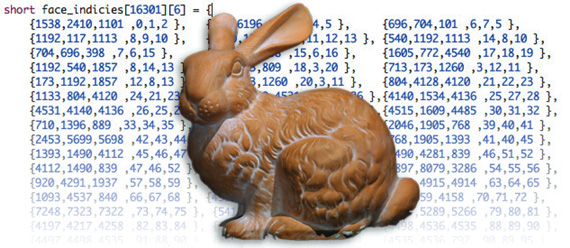The upload function sends object geometry to the GPU. The function needs to be invoked only once during the model loading stage.
glBindVertexArray( vao )
-
Activates object's state on the GPU.
glBindBuffer( GL_ARRAY_BUFFER, vbo )
-
Makes GL_ARRAY_BUFFER active, so the vertex data is uploaded to that particular buffer. The function attaches named buffer object (vbo) to a target named GL_ARRAY_BUFFER, which is used for vertex data, but may be re-bound later for other needs.
glBufferData( GL_ARRAY_BUFFER, buffer_size, NULL, GL_STATIC_DRAW )
-
Allocates GPU memory, where
-
buffer_size tells how big the buffer should be, and
-
GL_STATIC_DRAW specifies that the data will be loaded once and used many times, for example, once per frame.
-
glBufferSubData( GL_ARRAY_BUFFER, offset, total_vertices, vertices )
-
Provides the actual data. It is called separately for every component of vertex atributes -- vertices, normals, texture coordinates, and colors. However, the data here is "raw" - OpenGL does not know how the data is organized and what the data type is.
glVertexAttribPointer()
-
Specifies the data format. For example,
-
glVertexAttribPointer ( 0, 4, GL_FLOAT, GL_FALSE, 0, 0 );
The parameters are
-
0 is vertex attribute index, such as zero in layout(location=0) in shader code, or the attribute ID returned by glGetAttribLocation().
-
4 means four float components per vertex, as in (x, y, z, w). But if we wanted to include vertex color, then the number is different:
-
(x, y, z, w) = 4
-
(x, y, z) + (r, g, b, a) = 7
-
(x, y, z, w) + (r, g, b, a) = 8
-
-
GL_FLOAT specifies component type
-
GL_FALSE means "use the float values directly." Fixed-point data does not need to be normalized (converted to float) in a certain range ( -1, 1 signed or 0, 1 unsigned.)
-
0 is stride - byte offset (gap) between consecutive vertex attributes
-
0 is pointer - byte offset of the first component in the buffer
-
-
The result of Model::upload_2_server() is
-
GL_ARRAY_BUFFER identified by Model::vbo is populated with vertex data
-
The buffer exists on the graphics card

(Image from OpenGL Programming Guide for Mac)